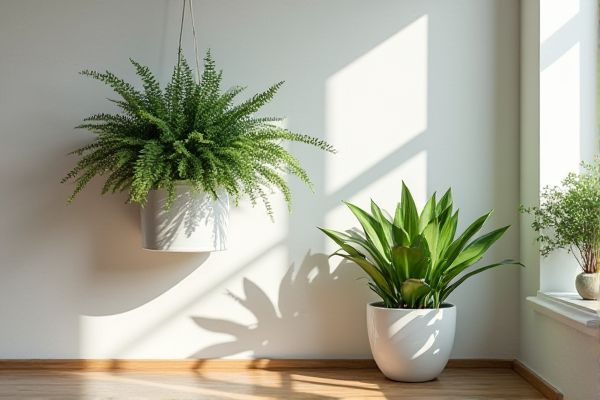
Wall planters save space and add vertical greenery, ideal for small areas or decorative displays, while floor planters offer larger planting options and mobility for your garden or patio. Discover which option best suits your needs and enhances your living space by reading the rest of the article.
Table of Comparison
| Feature | Wall Planter | Floor Planter |
|---|---|---|
| Placement | Mounted on walls | Placed on the floor |
| Space Efficiency | Ideal for small spaces | Requires floor space |
| Plant Size | Best for small to medium plants | Supports large plants |
| Design & Style | Modern, vertical gardening | Traditional, versatile styling |
| Installation | Requires wall mounting | Simple placement, no installation |
| Mobility | Fixed location | Portable and movable |
| Drainage | Needs built-in drainage or careful watering | Usually has better drainage options |
| Ideal Use | Urban gardening, decorative accents | Larger plants, patios, indoor gardens |
Introduction to Wall Planters and Floor Planters
Wall planters save space by mounting directly on vertical surfaces, making them ideal for small areas or adding greenery to walls. Floor planters provide stability and support for larger plants, allowing flexibility in placement and easy mobility within your living space. Choosing between your wall planter and floor planter depends on the available space and the type of plants you want to showcase.
Design and Aesthetic Differences
Wall planters offer a sleek, space-saving design that adds vertical interest and can act as living art on your walls, making them ideal for small spaces or accentuating room decor. Floor planters provide a more substantial presence with a variety of sizes and shapes, anchoring your greenery at eye level or below and allowing for larger plants or multiple arrangements. Your choice between wall and floor planters will influence the overall aesthetic by either maximizing vertical space and creating visual height or enhancing room grounding and plant accessibility.
Space Efficiency Comparison
Wall planters maximize vertical space utilization, making them ideal for small apartments or rooms with limited floor area. Floor planters require more ground space but offer greater flexibility for larger plants and easy mobility. Choosing between the two depends on available room dimensions and the types of plants intended for display.
Installation and Setup Requirements
Wall planters require secure mounting to studs or solid surfaces using anchors or screws, ensuring they can support the weight of soil and plants, making installation slightly more complex and time-consuming than floor planters. Floor planters offer easy setup with minimal assembly, simply needing stable, level ground to place on, which suits those seeking convenience and flexibility in plant arrangement. Your choice between the two depends on your available space, desired aesthetic, and readiness for installation effort.
Ideal Plant Types for Each Planter
Wall planters are ideal for trailing plants like pothos, ivy, and succulents, which thrive in vertical spaces and require less soil. Floor planters suit larger, root-heavy plants such as fiddle leaf figs, rubber plants, and tall palms, providing ample space for growth and stability. Choosing the right planter enhances Your plant's health and complements Your indoor or outdoor decor effectively.
Maintenance and Accessibility
Wall planters require minimal maintenance due to their limited soil volume and easier access for watering and pruning, making them ideal for small spaces. Floor planters generally hold more soil, supporting larger plants but demand more frequent watering and are less accessible for those with mobility issues. Choosing between the two hinges on balancing plant size preferences with ease of upkeep and accessibility.
Indoor vs Outdoor Applications
Wall planters maximize space in indoor areas, ideal for small apartments or offices where floor space is limited, offering vertical gardening solutions that enhance air quality and aesthetics. Floor planters provide flexibility for both indoor and outdoor settings, accommodating larger plants and creating focal points in gardens, patios, or living rooms. Your choice depends on spatial constraints and the environmental needs of the plants, as wall planters suit confined indoor spaces, while floor planters thrive in various indoor and outdoor environments.
Cost and Budget Considerations
Wall planters generally cost less upfront than floor planters due to smaller material usage and simpler installation requirements. Floor planters tend to be more expensive because of larger sizes, heavier materials, and the need for sturdier construction to support plant weight. Choosing between the two depends on Your budget constraints and desired aesthetic impact within your space.
Durability and Material Options
Wall planters often feature durable materials like metal, ceramic, and high-quality resin designed to withstand outdoor elements while saving space. Floor planters provide a broader range of material options including heavy-duty terracotta, concrete, and fiberglass, offering enhanced durability and stability for larger plants. Your choice depends on the desired placement and material benefits, with floor planters typically offering greater longevity for heavier vegetation.
Choosing the Right Planter for Your Space
Selecting the right planter depends on your available space and design goals; wall planters maximize vertical areas, ideal for small rooms or patios and can create living art displays. Floor planters offer larger capacity for root growth and can become statement pieces, suitable for spacious interiors or outdoor gardens. Your choice should balance aesthetic appeal, plant type, and spatial constraints to enhance both greenery and room functionality.
 homyna.com
homyna.com